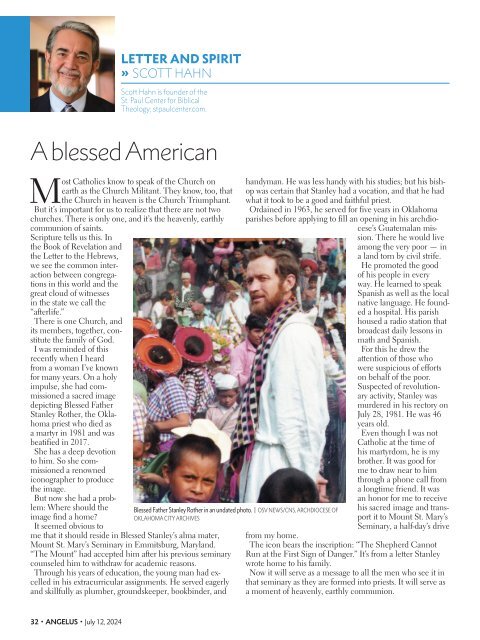Angelus News | July 12, 2024 | Vol. 9 No. 14
On the cover: A PBS series recently suggested purgatory was the “invention” of 14th-century Italian poet Dante Alighieri. Could it be true? Does such a place — somewhere between heaven and hell — really exist? On Page 10, contributing editor Mike Aquilina details purgatory’s biblical roots in the Old and New Testaments, all of which point to the hope and forgiveness God promises “in the age to come” to believers.
On the cover: A PBS series recently suggested purgatory was the “invention” of 14th-century Italian poet Dante Alighieri. Could it be true? Does such a place — somewhere between heaven and hell — really exist? On Page 10, contributing editor Mike Aquilina details purgatory’s biblical roots in the Old and New Testaments, all of which point to the hope and forgiveness God promises “in the age to come” to believers.
You also want an ePaper? Increase the reach of your titles
YUMPU automatically turns print PDFs into web optimized ePapers that Google loves.
LETTER AND SPIRIT<br />
SCOTT HAHN<br />
Scott Hahn is founder of the<br />
St. Paul Center for Biblical<br />
Theology; stpaulcenter.com.<br />
A blessed American<br />
Most Catholics know to speak of the Church on<br />
earth as the Church Militant. They know, too, that<br />
the Church in heaven is the Church Triumphant.<br />
But it’s important for us to realize that there are not two<br />
churches. There is only one, and it’s the heavenly, earthly<br />
communion of saints.<br />
Scripture tells us this. In<br />
the Book of Revelation and<br />
the Letter to the Hebrews,<br />
we see the common interaction<br />
between congregations<br />
in this world and the<br />
great cloud of witnesses<br />
in the state we call the<br />
“afterlife.”<br />
There is one Church, and<br />
its members, together, constitute<br />
the family of God.<br />
I was reminded of this<br />
recently when I heard<br />
from a woman I’ve known<br />
for many years. On a holy<br />
impulse, she had commissioned<br />
a sacred image<br />
depicting Blessed Father<br />
Stanley Rother, the Oklahoma<br />
priest who died as<br />
a martyr in 1981 and was<br />
beatified in 2017.<br />
She has a deep devotion<br />
to him. So she commissioned<br />
a renowned<br />
iconographer to produce<br />
the image.<br />
But now she had a problem:<br />
Where should the<br />
image find a home?<br />
It seemed obvious to<br />
me that it should reside in Blessed Stanley’s alma mater,<br />
Mount St. Mary’s Seminary in Emmitsburg, Maryland.<br />
“The Mount” had accepted him after his previous seminary<br />
counseled him to withdraw for academic reasons.<br />
Through his years of education, the young man had excelled<br />
in his extracurricular assignments. He served eagerly<br />
and skillfully as plumber, groundskeeper, bookbinder, and<br />
Blessed Father Stanley Rother in an undated photo. | OSV NEWS/CNS, ARCHDIOCESE OF<br />
OKLAHOMA CITY ARCHIVES<br />
handyman. He was less handy with his studies; but his bishop<br />
was certain that Stanley had a vocation, and that he had<br />
what it took to be a good and faithful priest.<br />
Ordained in 1963, he served for five years in Oklahoma<br />
parishes before applying to fill an opening in his archdiocese’s<br />
Guatemalan mission.<br />
There he would live<br />
among the very poor — in<br />
a land torn by civil strife.<br />
He promoted the good<br />
of his people in every<br />
way. He learned to speak<br />
Spanish as well as the local<br />
native language. He founded<br />
a hospital. His parish<br />
housed a radio station that<br />
broadcast daily lessons in<br />
math and Spanish.<br />
For this he drew the<br />
attention of those who<br />
were suspicious of efforts<br />
on behalf of the poor.<br />
Suspected of revolutionary<br />
activity, Stanley was<br />
murdered in his rectory on<br />
<strong>July</strong> 28, 1981. He was 46<br />
years old.<br />
Even though I was not<br />
Catholic at the time of<br />
his martyrdom, he is my<br />
brother. It was good for<br />
me to draw near to him<br />
through a phone call from<br />
a longtime friend. It was<br />
an honor for me to receive<br />
his sacred image and transport<br />
it to Mount St. Mary’s<br />
Seminary, a half-day’s drive<br />
from my home.<br />
The icon bears the inscription: “The Shepherd Cannot<br />
Run at the First Sign of Danger.” It’s from a letter Stanley<br />
wrote home to his family.<br />
<strong>No</strong>w it will serve as a message to all the men who see it in<br />
that seminary as they are formed into priests. It will serve as<br />
a moment of heavenly, earthly communion.<br />
32 • ANGELUS • <strong>July</strong> <strong>12</strong>, <strong>2024</strong>

















